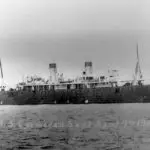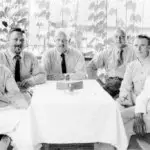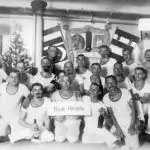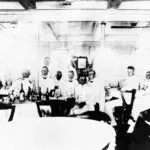Cormoran-Südseefahrer: SMS Cormoran Crew Annual Meetings
Table of Contents
Share This
By 1920, after the end of World War I, the men of the SMS Cormoran II who had been taken as prisoners of war by the United States were returned to their home country of Germany. The experience of being interned In Guam and then in US POW camps bonded these men together in a significant and personal way. Even though they went their separate ways back to their families the men of the Cormoran met yearly for over 40 years to remember, share stories, mourn lost comrades and stay in touch.
Not much is known about these early meetings; they were likely just informal gatherings of a few crew members. They seemed to take on a more formal air, however, after World War II and even included the collection of money and the printing of a newsletter to keep comrades abreast of each other’s whereabouts. The yearly meetings took place in various cities and were organized mostly by crew member Fritz Bayer, with assistance from Willi Silz, Claus Becker, Willi Haas, Rudi Reiher or their widows, over the years.
In 1937, there were 145 crew members for whom the organizing committee had addresses. The start of World War II, however, interrupted their annual meetings, the last one prior to the war being held in August 1939. Some of the men, including Cormoran Captain Adalbert Zuckschwerdt, had re-entered military service. The group got together again in the 1950s, and continued to meet regularly for the next three decades. Postwar politics, though, divided the country into two Germanys—the Federal Republic of Germany (West Germany) and the Democratic Republic of Germany (East Germany), making it difficult for East German counterparts to attend. Bayer continued to organize the meetings in West Germany and encouraged the men to attend and keep their information current, especially since after the war, more than 50 percent of the addresses were no longer valid, as many people had been exiled from the occupied or ceded territories during the postwar transition.
In 1953, the first newsletter was published and sent out after the meetings by Bayer with information about attendees, lost comrades and other anecdotes, and information for the following year’s gathering. Wives and widows were also encouraged to attend, as they made the gatherings more complete. Newcomers had to go through the ritual “Thee and Thou” and “Kissing Parade” as part of their welcome into the group.
The attendance at the meetings, of course, was voluntary, as were monetary donations for the group. The funds collected always went toward arrangements and accommodations for the meetings and the printing and postage for the newsletter, but also for the laying of funeral wreaths at the graves of comrades who died over the years. In addition, money was used to put together gift packages at Christmastime for comrades in East Germany who had fallen onto hard times.
Their meeting in April 1957 was of great significance, for it was the 40th commemoration of the scuttling of the Cormoran and their imprisonment in the US. Even the widow of Captain Zuckschwerdt sent a telegram with well wishes. Beyer described their gathering that year:
Sunday, 7 April 1957, the memorial day and the main day of this our meeting was preluded by divine service in the Protestant Church of Bad Tölz at the hour of the sinking of S.M.S. CORMORAN 40 years ago. The four front rows in the overfilled church were reserved for the old South Seafarers and their wives. There was a 3-men delegation of the Bad Tölz Navy Fellowship, in front of the altar, with the old war flag unfurled. Pastor Wunsiedler based his sermon on the moving story of our auxiliary cruiser CORMORAN and remembering our 7 dead comrades, and skillfully passed on from this unique fellowship and their struggles to life’s struggles in general. The social part of our meeting started on the evening of the same April 7, 1957, in the hospitable Hotel Hiedl. The rooms were transformed to look like a South Sea Paradise. Among the nice guests were the mayor in office, Mayor Toni Roth, who was already baptised by us during our meeting at Tölz in 1954, with much hilarity, as the ‘Knight Antonius of Lamutrik.’
Roth was just one of several “honorary members”—individuals who helped the former crew members and were dubbed with humorous names. “Lamutrik,” of course, is in reference to the Micronesian island of Lamotrek where the Cormoran stopped and was so low on fuel they were burning coconut husks to keep the boilers going. Another honorary member was Werner Vieten, who did all the paperwork for the men at the meetings. He was nicknamed the “Luluwei von Buka,” in reference to the chief of Buka in the Solomon Islands, one of the German Pacific territories, who had helped them during a native revolt in 1914. There was also Erich Windrath who was nicknamed the “Leader of the Chamorros in Piti,” where the Cormoran crew had been interned for two and half years; and American sailor John Wagner, who had been aboard the USS Supply, the ship that assisted in saving many of the crew members after the Cormoran exploded. Wagner connected with the group in 1958 and sent them each three photographs: the Cormoran, the Supply and one of himself on the Supply, for which they were very grateful.
In addition to widows and wives, there were also four women of German descent from German Samoa, who had entertained the crew and other German vessels during their visits to the islands around that time, and who had been welcomed to stay in touch with the group. They were Tina Bartel, Gertrude Braune, Mathilde Nolten and Agathe Röhr.
Plan to return to Guam
The men had asked Wagner if the graves of their comrades in Guam still existed, as they thought the heavy fighting during World War II may have destroyed them. They were also curious if people in Guam still remembered them. Wagner was able to reassure them that the graves were there still, and another former US Marine, Thomas Brennan, who had been stationed in Sumai in the 1930s, told Wagner he had heard the story of the Cormoran from the local people. This inspired the Cormoran men to consider planning a trip to Guam. The newsletter described the enthusiasm for planning such a journey but also the understanding that much time had passed and things may have changed:
A comrade suggests to take into consideration the even cheerful reception by the native Chamorros of GUAM, which will surely be such, as it has been reported to us that they tell about and narrate with pride even today the STORY OF THE CORMORAN and its crew who liked [lived?] ashore. It could even be assumed that at a reception at the pier in Piti eventual grandchildren and great grandchildren may appear. With the rapid growth there, the last mentioned could well be of confirmation respectively holy communion age. As gifts for these descendants a wristwatch could be recommended (it must be a gold one). Glass beads are not in favor anymore. The South Sea Islanders, too, have become more presumptuous in the last 40 years.
The Cormoran men were also particularly interested in this trip to visit the graves at the US Naval cemetery in Hagåtña. Unfortunately, they could not secure a vessel or permission from the US government to sail as a group to Guam to visit the graves. Guam was still under strict security and required a security clearance to enter the island. The reason the Navy gave, though, was that they feared granting this request to the Cormoran crew would set up a precedent for similar requests from numerous others to visit their dead comrades. The men of the Cormoran resigned themselves to not going to Guam as a group, but took comfort in the fact that they still had their memories of their time in Guam and the way it looked then—untouched by modernization.
Contacted by Herbert Ward
Around this time, American engineer Herbert Ward had been working in Guam and had been diving the Cormoran wreck in Apra Harbor, salvaging artifacts including Captain Zuckschwerdt’s swords, silverware, uniform buttons, pipes and decorative pieces the Cormoran crew had collected during their travels. Ward, who was doing research for his book, The Flight of the Cormoran, had connected with Fritz Bayer and shared information about what he had found.
The Cormoran men were grateful for Ward’s interactions with them, in particular on the 50th anniversary in 1967, when Ward offered to lay a wreath in their name on the main commemoration stone around which the graves of the fallen men were buried in Guam. According to Bayer, the blue ribbon on the wreath read: “The Comrades of S.M.S. Cormoran, on 7 April 1967, Remember their comrades who lost their lives on 7 April 1917.” Ward sent them photographs of the graves and news clippings of the event. Ward was also able to visit Lamotrek and inform the group that the gravestone of comrade Paul Glaser (originally from the SMS Planet) was still there. Most everyone they had interacted with on the island, though, had passed away, including the group of dancing teenagers that had been photographed (which Ward featured in his book). Only Leti, the daughter of the English trader Mr. Henry Simms who assisted them while they were stopped there, was still alive at the time Ward visited, but Ward had not been able to reach her directly.
That year, as well, a new naval vessel named the SMS Planet was launched. Bayer and the meeting committee were inspired to get more crew men from the original Planet who had joined them in Yap before being interned in Guam in 1914 to attend their reunions. They renewed their efforts after some of the Cormoran men were able to see the new ship, but no original Planet crew men responded to their queries.
Comrades forever
As the 1960s moved forward into the 1970s, the Cormoran crew members became even fewer and fewer in number. Only a handful were present at the meetings in the early 1970s. Most of the men were no longer able to attend or stay in touch after becoming ill or when they or their wives passed away. Bayer himself upon the death of his wife and his own failing health turned over organizing the meetings and putting together the newsletter. Guampedia’s research has not been able to discern when (or if) the annual meetings finally came to an end. But it is clear that these meetings were very important to the survivors of the Cormoran. Elisabeth Heim, granddaughter of crew member Emil Bischoff (1889-1967), a machinist (Masch. Mt.), related that her grandfather had very happy memories of his time in Guam. Bischoff attended the reunion meetings from 1962 until his death in 1966. The meetings gave him a chance to share stories again with his comrades, and to find a ready audience interested in hearing them. Heim declared the meetings gave the men, including her grandfather, a great “sense of camaraderie.”
In the newsletter from 1972, a poem, penned by the Hotel Jungmann innkeeper, Manfred du Mesnil, was printed and that poignantly captured the spirit of the men who attended the reunions over the years:
Ihr Cormoraner, Ihr lieben Leut
Versammelt seit Ihr lustig heut
ob Tetje, Arthur oder Olle
Ein jeder stemmt heut seine Molle
Jahrsehnte Freunde, in der Seefahrt erfahren
das hielt und hält Euch zusammen als Kameraden
Drum bleibt fröliche Menschen
Heute und dann und wann.
You Cormoranians, you dear folks,
Are happily assembled today.
Whether named Tetje, Arthur or Olle,
Each one today is firmly supporting his standard.
Friends since decennials, experienced in seafaring,
Which bonded and still bonds you together as comrades.
Therefore, continue to be merry, folks,
Today and now and then again.
This sense of fellowship was reflected in the dedication the men of the Cormoran continued to have for each other for half a century after history threw them together on a tiny island in the Pacific, and in the motto of the SMS Cormoran crew that closed each newsletter—a fitting epitaph to the memory of the men bonded by the experience of war: Alle Mann an Bord—All Men on Board!
Reunion Meeting Newsletter 1966
Editor’s note: The Richard A. Taitano Micronesian Area Research Center (MARC) at the University of Guam has these newsletters, in the original German and translated into English for Herbert Ward, as part of the Herbert Ward Collection.




